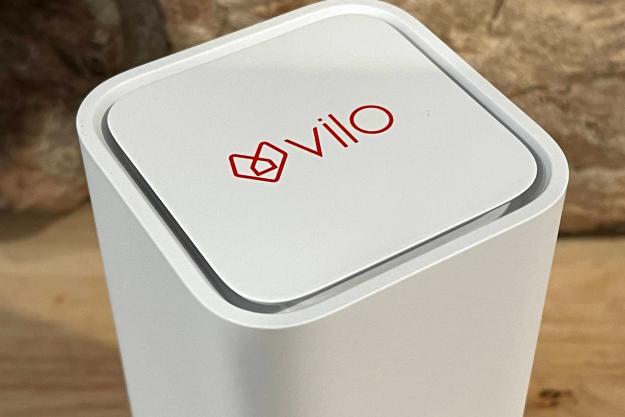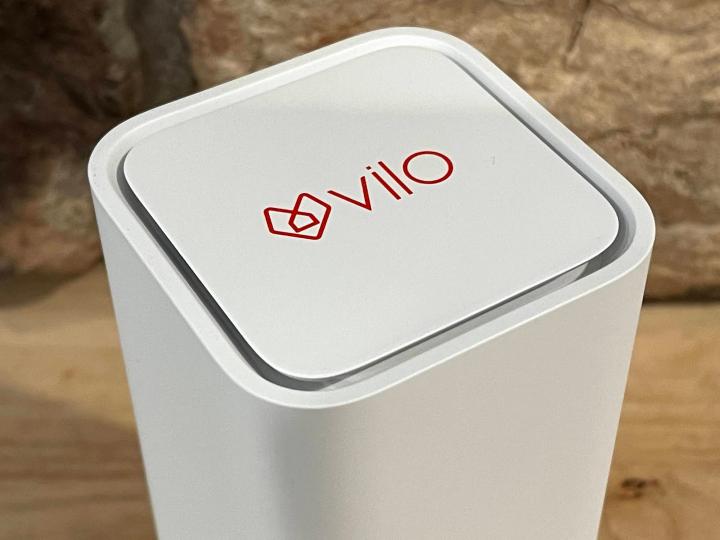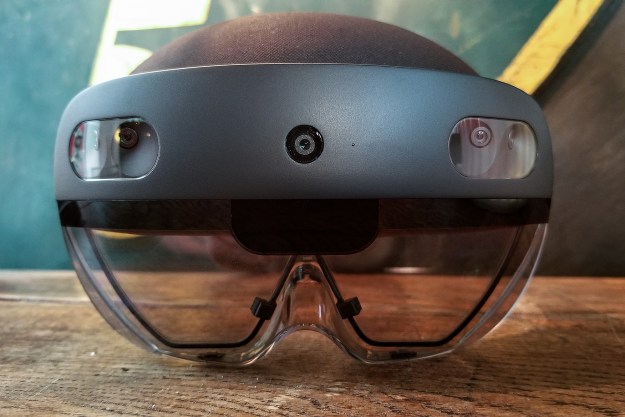
“Compared to the competition, you can save 90% of the cost by sacrificing just 30% of the speed with Vilo.”
- Affordable price
- Easy setup with intuitive app
- Plenty of Ethernet ports to get wired connection
- Compact, attractive design that’s expandable
- No Wi-Fi 6 support
- Some speed and connection issues
- No WPA3 support
Mesh routers are a great option for your home Wi-Fi needs, but the prices of these systems often make them inaccessible for many households. Vilo is looking to upend the home mesh Wi-Fi market with an affordable system of its own.
Priced at just $20 for a single router or $60 for a three-pack that connects together to blanket up to a 4,500-square-foot home, Vilo promises to connect up to 120 devices at a time at a fraction of the cost of competing units.
It’s roughly one-fifth the cost of the competing Linksys Velop Mesh Wi-Fi system, so obviously, Vilo had to make some compromises. But it cuts corners in the right places, balancing performance and features with its extremely attractive price.
Jump to: Design | Specs and features | Setup | Performance | Our take
Design

Vilo’s mesh routers can be purchased in a pack of one — ideal for smaller spaces and offices — or a larger pack of three designed to blanket larger homes. Each unit, called a node, is identical and interchangeable, so it can be used as either a satellite or the main router directly connected to the modem.
The Vilo units appear much more premium than they are, and nothing about the Vilo’s build quality would betray it’s $20 price. In fact, the minimalist square-shaped canister design — and the unit’s non-glossy white finish — reminds me of Linksys’ more premium Velop mesh system. The Velop retails for a whopping $229 to $300 for a three-pack by comparison.
Like the Velop, the Vilo is very lightweight and it’s compact design — 5.9 x 2.7 x 2.7 inches — is no larger than a tall can of iced tea. The simple design of this unit is made to blend in with your furniture and home decor.

Unlike traditional Wi-Fi routers, mesh systems don’t come with intimating, protruding antennas that resemble alien-like tentacles. The goal with these systems is that the more stylish design means that you’ll want to place these units throughout your living space to deliver better Wi-Fi coverage, rather than hide the mesh system and obfuscate its signal behind furniture and appliances.
On the front of each Vilo, you’ll find a recessed circular button that can be used to quickly disable network connectivity to that specific node. as well as a network status indicator LED light. When the Vilo starts up, the LED is red, but it will switch to a solid blue when you’re connected to the internet and the system is ready. A flashing blue light shows spotty Internet coverage, while amber shows that the unit is ready to be paired and setup.
If you’re sensitive to light or don’t want Vilo’s LED to disturb your home’s ambient lighting, you may want to cover the LED hole with some white tape for a cleaner aesthetic.

On the rear, each unit comes with three Ethernet ports to accommodate wired connections if needed. Having Ethernet ports on satellite units can come in handy for gamers who may need a reliable connection and have their modem or main mesh router in a different room, or for connecting IoT devices in remote corners of your home. The ports here don’t deliver the same speeds that you can expect when plugging directly into your modem, but can help in maintaining a more stable connection for more critical applications.
Having the Ethernet ports on satellite units is a welcome change from my older Amazon Eero system that lacked support for wired Ethernet connections on satellites. In general, I use the Ethernet ports on my satellite nodes for plugging in my gaming console, a home IoT hub that doesn’t come with built-in Wi-Fi, and my desktop PC.
Specs and features

At just $20 a unit, you won’t find support for the latest Wi-Fi 6 or Wi-Fi 6E specifications on the Vilo. Still, with dual-band 802.11ac on board, you’re getting the same Wi-Fi 5 support that’s found on something like the more premium Linksys Velop AC2200 mesh system. Unlike Vilo, Linksys does offer a more premium version of its Velop system with Wi-Fi 6 support.
The main difference here is that the $229 Velop features a triband antenna for better coverage and reliability, whereas the cheaper Vilo resorts to a dual-band antenna. At its significantly lower price, you will still benefit from MU-MIMO connections, beamforming, and band steering on the Vilo. Band steering can be configured through the Vilo Living app, which is available on both iOS and Android. The app’s dashboard gives you additional information about your mesh network, like your Wi-Fi signal strength, the firmware version that’s running, and your choice of encryption method.

Setting up your home Wi-Fi network will require you to use the app. Each Vilo unit comes with a QR code on the bottom, and once you’re registered and logged into the app, it will prompt you to scan the QR code of the main unit first — this is the one that’s plugged directly into the router. If you buy a multipack, subsequent satellites will automatically be detected after you plug them in. While Vilo offers a three-pack configuration, you can purchase additional nodes and pair them to your system if your home requires it. Like competing mesh systems, the app gives you plenty of control and information about your home network in a nonintimidating way.
Another benefit with the app is that parents can control the network to schedule downtime where individual devices are blocked off. If you have young kids, it’s an added layer to the digital well-being apps that are built into many modern phones, and it could help establish healthy internet habits.
You can also block specific websites, create a guest network for visitors to use with a separate password, and remotely restart your mesh system if there are any glitches. And if you’re into data, you can also view a usage report to see how much data each device is using. For guest networks, Vilo allows you to set up temporary ones with an expiration time or a permanent one, giving you lots of flexibility to change your password and settings to keep things secure.
Setup
I tested a three-pack of the Vilo system at my parents’ home, which is larger than my smaller apartment and a better indicator of how the units perform together as a mesh network. In my smaller space, a one-unit modem would have sufficed.
For the test environment, I replaced the existing Eero Pro 6 network at home with the Vilo network. I placed a unit in the upstairs bedroom in the back of the house, one in the living room downstairs in the front of the house, and one in the garage.
Because of the way the home is laid out, the garage has always been a Wi-Fi dead zone, and in the past, my parents would place repeaters or a mesh node in the garage so they could control their connected garage door opener and Ring cameras. Because each unit needs to be plugged into power, their placement must be close to a power outlet.
Performance

Like a network of cell phone towers, the mesh system would determine which node provides the best connection and switch your device to the strongest node as you move around the space. This all happens seamlessly, and in theory, you should get the best Wi-Fi reception without having to change to a different network every time you step into a different coverage zone.
To test the performance of the Vilo, I wanted to see if there are speed degradations and differences incoverage reliability as I moved around the space. I know that my parents have 300 Mbps symmetrical speeds from their local internet service provider (ISP), and connecting my iPhone directly to the ISP’s provided router-modem combo gave me speeds in that range.
The range runs from the lowest speed of 280Mbps to the highest speed of 325Mbps. Vilo’s unit supports a maximum of 867Mbps on the 5GHz band and up to 500Mbps on the 2.4GHz band.
Vilo sayst each unit has four internal antennas and can handle multiple users with MU-MIMO, making it reliable for various devices connected simultaneously. Beamforming is also used to help route the signals to the devices from the nodes, and band steering automatically sets each device to either the 2.4GHz or 5GHz band.
You can turn off band steering, if necessary, in Vilo’s app for devices that require a specific connection to a 2.4GHz band. I disabled band steering for the test and instead forced Vilo to rely on the 5GHz band for our tests so that the ISP speeds weren’t capped by the lower band.

Running speed tests throughout various points in the home, I found that the Vilo network was on average 30% slower than the Eero Pro 6, averaging just over 350Mbps across multiple locations in the house. Still, a three-unit pack of the Eero Pro 6 costs $599 for a three-pack.
This means that you can save 90% of the cost by sacrificing just 30% of the speed, making the Vilo a serious winner for most average households.
Not all was dire, however. In the living room connected to the main node — the unit that’s attached directly into the modem — speeds averaged higher at around 400 Mbps. Moving to the opposite end of the house with just the main node running, speeds hovered close to 200 Mbps.
When a satellite was used in the same location in the house, speeds were about 250 Mbps. In the garage with its infamous Wi-Fi dead zone, speeds were around 75 Mbps during my speed test — that’s 15% of the 500Mbps promised by my ISP.
Compared to the Eero Pro 6 system, the drop-off in speeds wasn’t as drastic as the Vilo. In the living room, the Eero Pro 6 performed close to 450 Mbps, so it’s marginally faster than the Vilo in this setting. However, off of the main node, when moving to the opposite end of the house, speeds were much faster than the Vilo at 320Mbps on average. In that same location with a satellite unit, speeds were more than 100Mbps faster on average at 370Mbps. And in the garage, the Eero still delivered close to 150 Mbps on the dedicated node for that space.
The biggest gripe with the Vilo is that the handoff between different nodes doesn’t work as well as on competing systems. That is a problem if you begin your connection on one end of the home on one node and then move to another spot in the home that should have been serviced by a different node for optimal speed and coverage.
This doesn’t happen a lot, but I did notice it when moving from the garden — where I had decent Wi-Fi coverage on my phone when connected to the node from the upstairs bedroom — to the front of house, which should have been serviced by the main node in the living room. After I had migrated, not only did my Wi-Fi reception plummet — indicating I was connected to a more remote node — but because of weaker reception, my speeds also drastically dropped.
While this isn’t a common concern for most families — you really are working on your laptop or tablet in mostly one spot — it is an issue if you’re FaceTiming or video calling with people while walking around the house.
Speeds are just one part of the story when it comes to Wi-Fi networks. In use, I found the Vilo system was very reliable in general. In the month that I’ve used the Vilo network — both at the test site at my parents’ home and my apartment — the network had to be restarted twice.
The first time was after a software update that caused a glitch where one of the satellites was not recognized, and the second occurred when devices that were connected to Vilo’s network could not get access to the internet.
Though this may seem frustrating, the glitches can more easily be overlooked at Vilo’s lower price point. Compared to my older Wi-Fi 5 Eero system, the Amazon-branded network performs much more reliably today, but when it first launched, I’d experience the same glitches twice or three times a year, and mostly after software updates.
Our take
If you don’t already own a home mesh network, the Vilo system should be on the top of the list. While Vilo compromises on more modern features — the system lacks an option for Wi-Fi 6 support and it comes with a dual-band, rather than a triband antenna for even more robust coverage — its affordable $20 starting price for a single router unit or $60 for a three-pack makes Vilo a great value for those looking to switch to a home Wi-Fi mesh system.
Are there any alternatives?
Some of Vilo’s bigger competitors include Amazon’s Eero, Logitech’s Velop, and Google’s Nest Wi-Fi. And while Wi-Fi 6 is supported on some of the more expensive models, like the Eero 6 or Velop AX4200 Wi-Fi 6 system, you’ll be paying a premium for this technology. At present, Wi-Fi 6 hasn’t quite taken off yet, and even if your current smartphone or laptop supports it, most homes in the U.S. don’t have the broadband speeds to take advantage of Wi-Fi 6.
According to Ookla’s Speedtest.net, most homes in the country average around 192Mbps for fixed broadband. Vilo’s Wi-Fi 5 network supports up to 867Mbps, which should competently handle most broadband plans with sub-gigabit speeds.
In addition to mesh networks, Vilo also competes against traditional Wi-Fi routers, especially when they’re coupled with range extenders.
How long will it last?
Vilo offers a limited one-year warranty to cover any defects in the hardware. And unlike smartphones, Wi-Fi units are often stationary, so they aren’t prone to accidental damage. With a smart device like a mesh router, you also gain years of support through software updates that happen in the background, ensuring that your Vilo network lasts for years. In general, the Vilo network should last you until you upgrade to home broadband speeds that are faster than 1Gbps.
Should you buy it?
Unless you need Wi-Fi 6, if you don’t already own a mesh Wi-Fi system, you should absolutely consider upgrading to the Vilo mesh. The unit boasts stylish good looks, although it does makes some compromises with speeds. But at $60 for a whole-home network, the speed drop-offs don’t really matter much for prudent shoppers, as long as the system works as advertised and you can get reliable reception in the most remote corners of your home.
Editors' Recommendations
- Is Microsoft’s new PC cleaner just an Edge ad in disguise?
- Chrome just added a great new way to protect your passwords
- TCL’s new routers give you 5G speeds at home and on the go
- Apple may have just leaked its VR headset’s operating system
- Bose updates speakers and soundbars with Chromecast built-in







